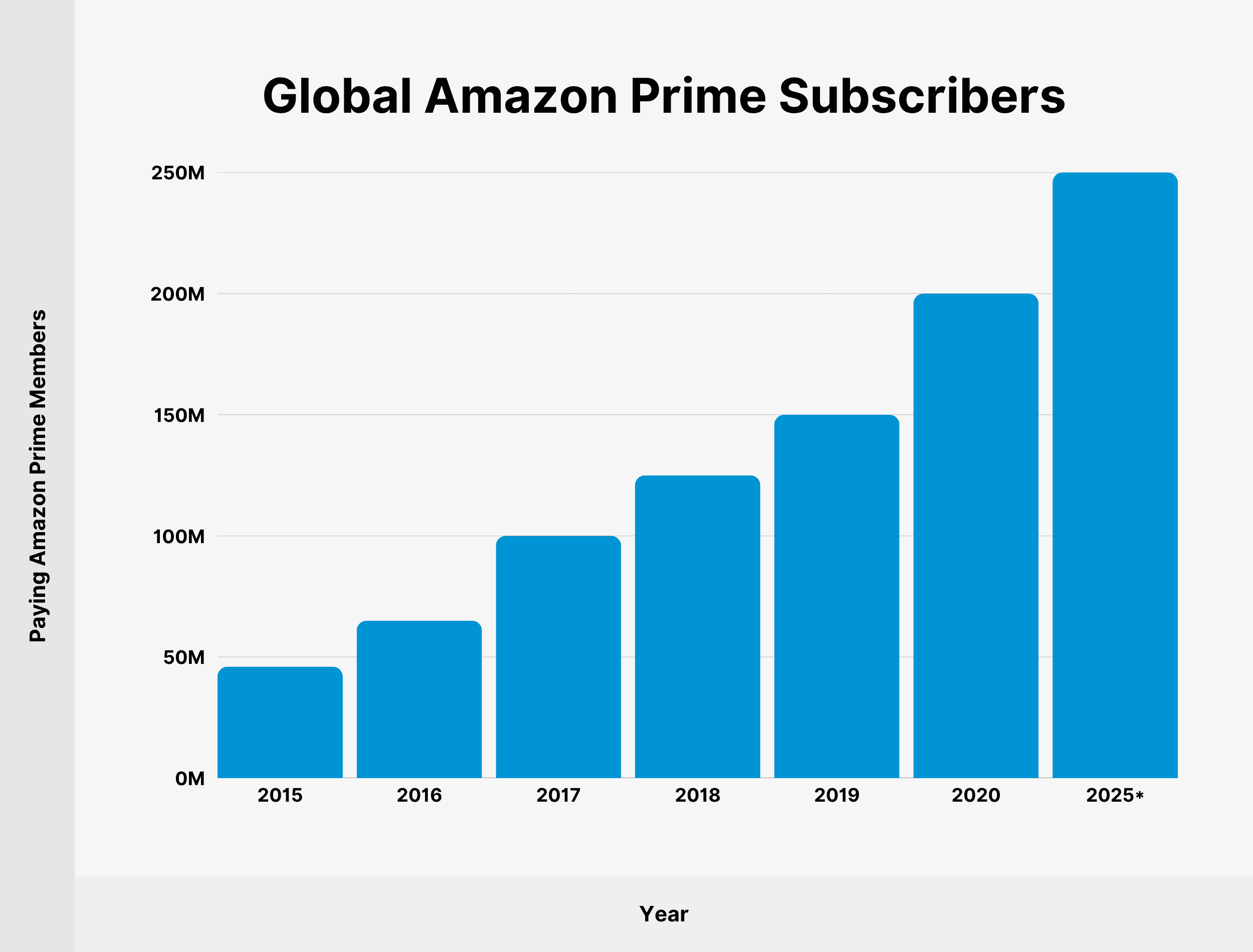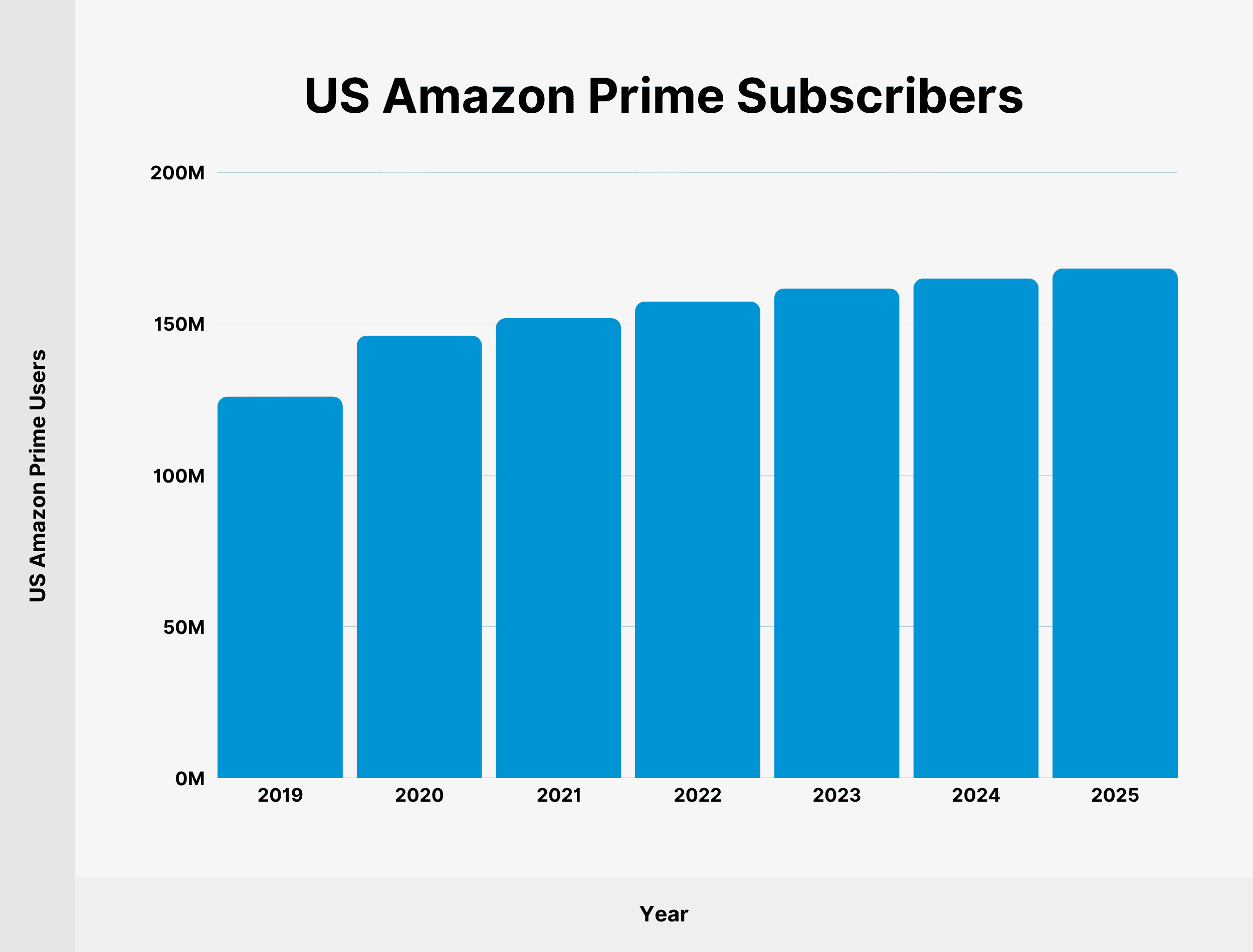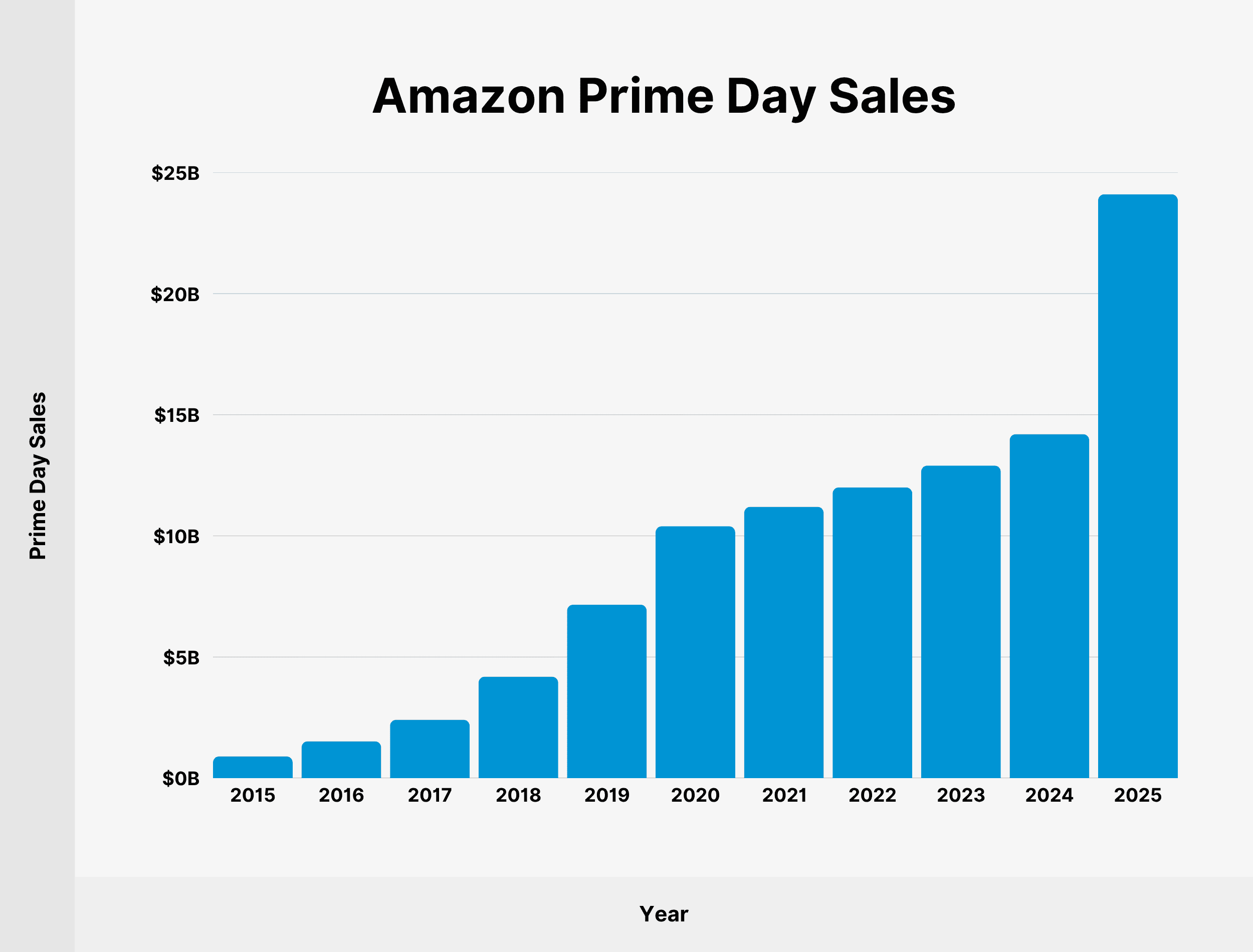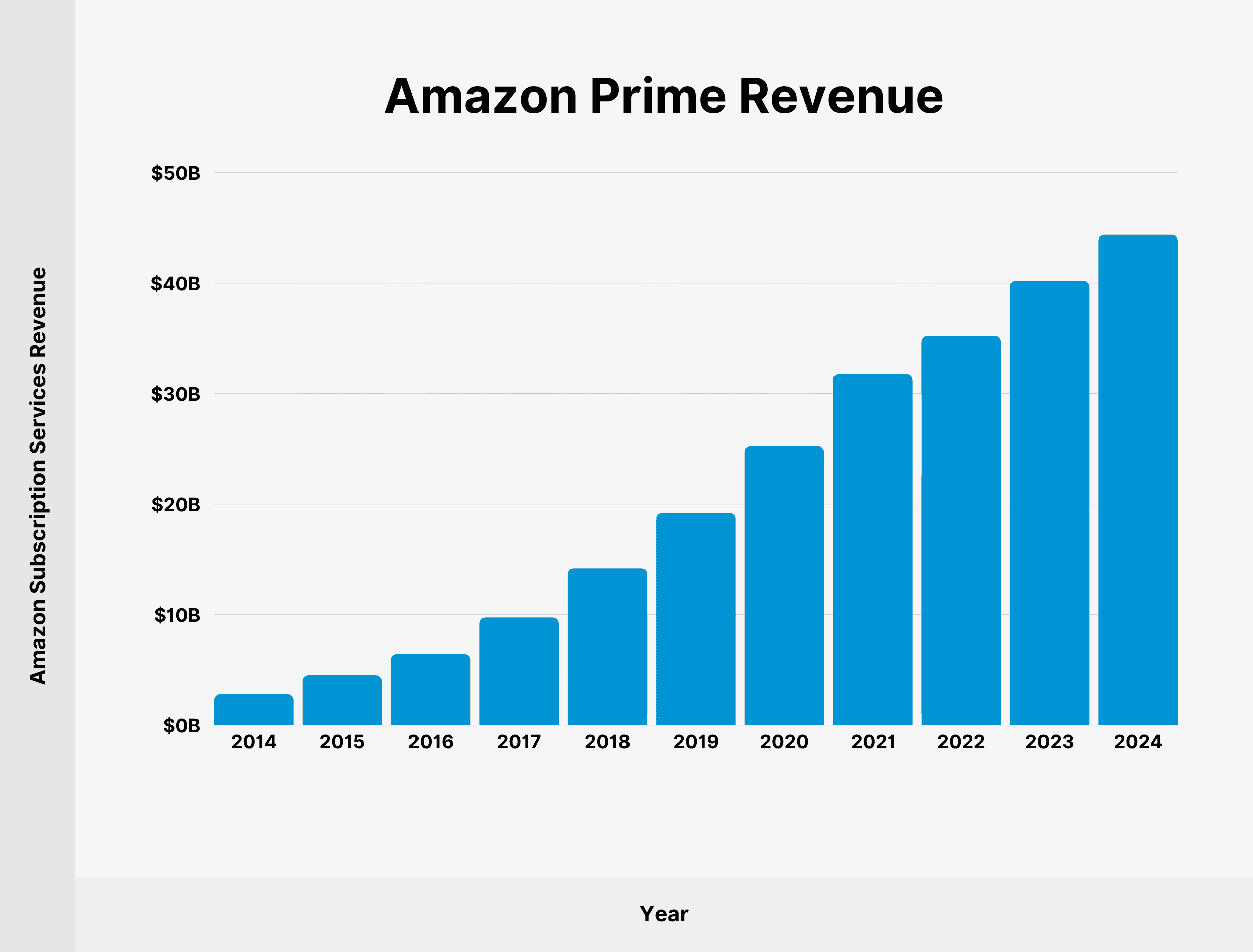Amazon Prime launched in 2005 as an Amazon membership service offering free two-day shipping.
It gained limited customer traction during the first years, but after 2011, it started quickly taking off and now has more than 250 million members across 27 countries.
Prime membership has evolved and now includes streaming, shopping, reading, and other benefits besides free shipping.
You’ll find out the latest information about Amazon Prime growth and usage data in this roundup. After reading these stats, you’ll better understand how Amazon manages to register over $40 billion from subscription fees alone.
Important Amazon Prime Stats
- Amazon has approximately 250 million Prime members.
- Sales during Amazon Prime Day reached $24.1 billion in 2025.
- Amazon Prime is currently available in 27 countries.
- Amazon brought in $44.37 billion in revenue from subscription fees in 2024.
Global Amazon Prime Subscribers
Globally, Amazon has an estimated 250 million Amazon Prime subscribers.

Amazon doubled its Prime subscriber base between 2017 (100 million) and 2020 (200 million).
| Year | Paying Amazon Prime Members |
|---|---|
| 2015 | 46 million |
| 2016 | 65 million |
| 2017 | 100 million |
| 2018 | 125 million |
| 2019 | 150 million |
| 2020 | 200 million |
| 2025 Estimate | 250 million |
Sources: Business of Apps, Amazon, Statista
US Amazon Prime Subscribers
According to CIRP estimates, 184 million Amazon customers had an Amazon membership as of June 2024. That’s an 8.2% year-over-year increase from 170 million US Amazon Prime members in June 2023.
According to eMarketer estimates, 168.3 million adults in the US use Amazon Prime as of 2025.

Between 2021 and 2025, US Amazon Prime users are expected to grow by 16.4 million, accounting for 62.4% of the total population.
Here’s a table with Amazon Prime user growth in the US:
| Year | US Amazon Prime Users |
|---|---|
| 2019 | 126 million |
| 2020 | 146.1 million |
| 2021 | 151.9 million |
| 2022 | 157.4 million |
| 2023 | 161.7 million |
| 2024 | 165 million |
| 2025 | 168.3 million |
Sources: CIRP, eMarketer 1, eMarketer 2
Amazon Prime Day Sales
Launched in 2015, Prime Day is an annual deal event available exclusively to Prime members.
According to Adobe Analytics, US consumer spending during the Amazon Prime Day event reached $24.1 billion in 2025. That represents a 30.3% year-over-year increase.

Here’s the table on sales growth of Amazon Prime Day since 2015:
| Year | Prime Day Sales |
|---|---|
| 2015 | $0.9 billion |
| 2016 | $1.52 billion |
| 2017 | $2.41 billion |
| 2018 | $4.19 billion |
| 2019 | $7.16 billion |
| 2020 | $10.4 billion |
| 2021 | $11.2 billion |
| 2022 | $12 billion |
| 2023 | $12.9 billion |
| 2024 | $14.2 billion |
| 2025 | $24.1 billion |
Sources: Adobe Analytics, Statista
Amazon Prime Revenue
Amazon Prime revenue cannot be entirely isolated from Amazon’s overall revenue.
However, Amazon does disclose the net sales of all subscription services, including Amazon Prime-related membership fees, digital video, audiobooks, digital music, e-books, and other subscription services (excluding AWS).

Here’s a breakdown of Amazon’s subscription services revenue:
| Year | Amazon Subscription Services Revenue |
|---|---|
| 2014 | $2.76 billion |
| 2015 | $4.47 billion |
| 2016 | $6.39 billion |
| 2017 | $9.72 billion |
| 2018 | $14.17 billion |
| 2019 | $19.21 billion |
| 2020 | $25.21 billion |
| 2021 | $31.77 billion |
| 2022 | $35.22 billion |
| 2023 | $40.2 billion |
| 2024 | $44.37 billion |
Amazon Prime Video Users
According to the company, Amazon Prime Video has an ad-supported reach of 200 million customers worldwide, including 115 million in the US.
According to eMarketer estimates, the number of Amazon Prime Video viewers in the US reached 163.6 million in 2024. For comparison, Netflix has around 173.7 million viewers in the US.

Here’s a detailed breakdown of Amazon Prime Video viewers in select countries as of 2024:
| Country | Amazon Prime Video Viewers |
|---|---|
| United States | 163.6 million |
| India | 65.9 million |
| Germany | 32.3 million |
| United Kingdom | 26.9 million |
| Japan | 16.2 million |
| Canada | 14.6 million |
| France | 13.6 million |
| Australia | 4.9 million |
How Many Countries Have Amazon Prime?
Amazon Prime is currently available in 27 countries.

Here’s the table with international expansion milestones of Amazon Prime since 2007:
| Country | Year of Amazon Prime Launch |
|---|---|
| Germany, Japan, UK, US + others | 2007 |
| France | 2008 |
| Italy | 2011 |
| Canada | 2013 |
| India | 2016 |
| Mexico | 2017 |
| Turkey | 2020 |
| Sweden, Poland | 2021 |
| Egypt | 2022 |
Sources: Amazon 1, Amazon 2, Wikipedia
Conclusion
That just about wraps up my Amazon Prime growth statistics.
While Amazon is a publicly traded company, the information it provides on its membership program is relatively limited. I’ve done my best to provide you with a comprehensive overview of Amazon Prime user and revenue data in one place.
Backlinko is owned by Semrush. We’re still obsessed with bringing you world-class SEO insights, backed by hands-on experience. Unless otherwise noted, this content was written by either an employee or paid contractor of Semrush Inc.

